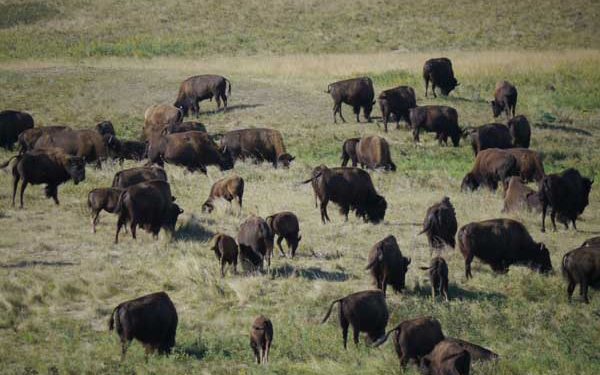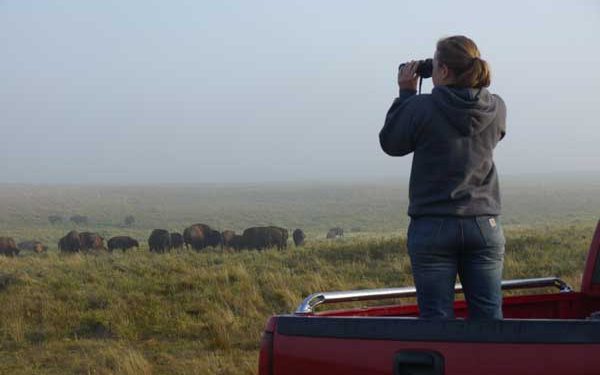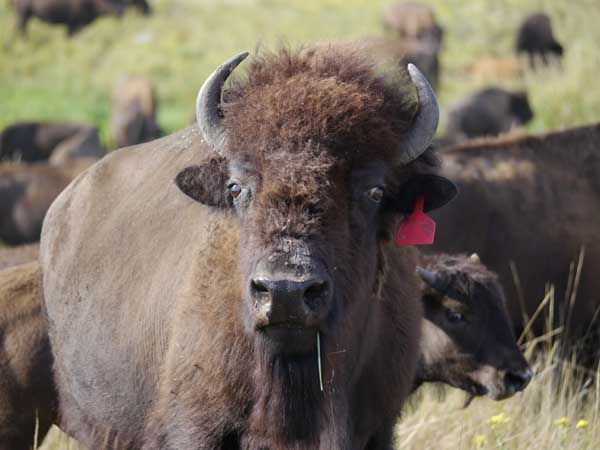Remove the oldest, most dominant bison bulls from a herd, and what happens? Will the bison still act like bison?
Those questions frame the latest chapter in bison research at the Conservancy’s Samuel H. Ordway Prairie Preserve in South Dakota.
For the past seven summers, students and a seasonal field crew have been studying bison behavior under the leadership of Jon Grinnell, professor of biology at Gustavus Adolphus College.
The effort began as an animal behavior project to study rutting bulls, but conservationists realized that the lessons learned could help better manage bison on fenced preserves – where most bison roam today. The research lessons could even help ensure the long-term survival of the species.
In past years, students studied how bulls competed for cows. Typically, the oldest bulls dominated.
But this year, there was a twist: all the bulls older than seven years – the ones that would typically be the most dominant – were removed from the preserve. This mirrors the management of many private ranches, which often remove bulls as they become larger and more difficult to handle. But some conservationists fear removing the older, dominant bulls could affect the genetic diversity of the herd. Could those old bulls have profound effects on mating.

Ordway, with its history of bison research, is the perfect place to test this. Without the older bulls, would the bison still fight and breed in the same ways?
The data are being compiled now, so it’s too early to tell. But I recently caught up with two seasonal team members who participated in the past two seasons, Juliana Gehant and Jess Richert. I wanted to see if they noticed anything different happening.
“There weren’t as many or as severe fights,” says Richert. “You might see a bull tending a cow, with another bull standing right by the cow, and no fighting happening. That would have not happened last year.”
In previous years, the bison researchers were in the field in the early morning and late evening every day to document fights. This year, though, they were having a hard time figuring out when, or if, fights were occurring.
“They didn’t seem to follow any patterns,” says Richert. “The bison moved around but they seemed to be resting a lot more.”

Richert noted that some much younger bulls may have mated successfully with cows, something that rarely happened in previous years. (Researchers will have to test genetics on calves to determine if those matings were actually successful).
Spending every day in the field living with bison, the researchers get to know the animals well. And they noticed that some formerly unsuccessful bulls had a distinct change in luck.
A bull named Shortay, for instance. Shortay was a favorite of students last year (and plays a supporting role in a previous blog on bison research).
He was the bull that never got the cows. But not for lack of trying.
Most bulls go out of their way to minimize fighting, Gehant notes. After all, fights take a lot of energy and can lead to serious injury. As such, bulls spend a lot of time circling around, sizing each other up and bellowing. They’re trying to intimidate the other bull into giving up without a fight.
Not Shortay. “He would just rush right up to a bull and go for the fight,” says Gehant. “It was what you might call an unorthodox approach. And last year, it didn’t work.”
This year, though, Shortay’s charges were more productive. In fact, he behaved much like the top bull on the prairie. “Typically, the young bulls fight for the cows early in the season while the dominant bulls save their energy and wait until the peak,” says Gehant. “That’s what Shortay did this year. And this year, his charging worked.”

Could behavior like this have implications for conservation management? Does it really affect the genetic diversity of the herd?
Both Richert and Gehant caution that these observations may not be related to the removal of older, more dominant bulls. “This year was a lot cooler than past years,” says Richert. “Could that have been a factor in the behavior? We don’t know yet.”
The data will be published in the coming months, hopefully yielding some clues. We’ll post the results on Cool Green Science.
The Conservancy has 5500 bison on twelve preserves, which presents an incredible opportunity to research the animals and ensure a bright future for the species. Can bison remain a viable species while living on fenced preserves and ranches? The research done by the students and seasonal staff at Ordway will provide critical information to answer that question.




Was this story ever followed up on?
“The data will be published in the coming months, hopefully yielding some clues. We’ll post the results on Cool Green Science.”
What was done to the older Bulls that was culled from the herd? Were they returned to the herd or sold for slaughter?
A step toward domestication. Do we want that?
Very interesting! Keep up the good work!
Thanks for the nice blog! I second what Matt wrote, TNC reserves provide a great opportunity to look closely at what’s happening in prairie (and other) systems, and in this case try to figure out how we can manage bison for both genetic and behavioral diversity. They’re wonderful animals that deserve the attention. I’ll let you know what my students and I find out.